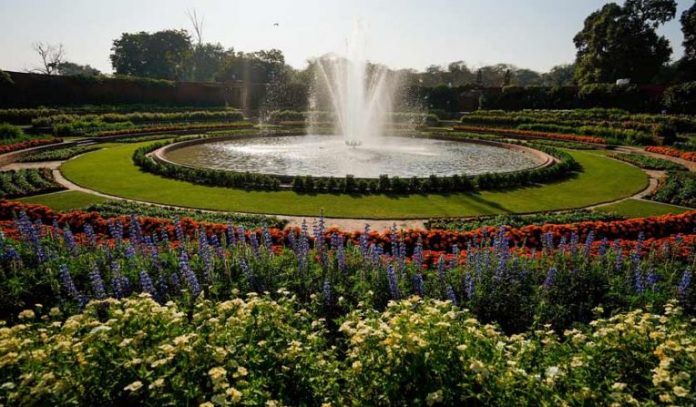The iconic Mughal Gardens at the Rashtrapati Bhavan (President’s House) in Delhi have been renamed. “The collective identity of all the gardens at Rashtrapati Bhavan will be ‘Amrit Udyan’. Earlier there were descriptive identities, now a new identity has been given to the gardens,” said Ajay Singh, the President’s press secretary.
The gardens will open to the public on January 31.
The renaming has drawn a mixed response, with some calling it “long overdue”, while others claim it is yet another instance of petty politics.
On the occasion of the celebrations of 75 years of Independence as ‘Azadi ka Amrit Mahotsav’, the President of India is pleased to give a common name to the Rashtrapati Bhavan gardens as ‘Amrit Udyan’, Navika Gupta, Deputy Press Secretary to the President, said in the statement.
The government had last year renamed Delhi’s famed Rajpath as “Kartavya Path”. The renaming of the stretch and other institutions is in line with the Centre’s effort to remove any trace of colonial mindset. “Rashtrapati Bhavan is home to a rich variety of gardens. Originally, they included East Lawn, Central Lawn, Long Garden and Circular Garden. During the term of former Presidents Dr A P J Abdul Kalam and Shri Ram Nath Kovind, more gardens were developed, namely, Herbal-I, Herbal-II, Tactile Garden, Bonsai Garden and Arogya Vanam,” it said.
In this year’s Udyan Utsav, among several other attractions, visitors will be able to see specially cultivated tulips of 12 unique varieties which are expected to bloom in phases, the statement said.
This time the gardens (Herbal Garden, Bonsai Garden, Central Lawn, Long Garden and Circular Garden) will be open for about two months.
The gardens will open for general public on January 31, 2023 and will remain open till March 26, 2023 (except on Mondays which are maintenance days and on March 8 on account of Holi).
From March 28 to 31, the gardens will be open for special categories — for farmers on March 28, for differently abled on March 29, for personnel of defence forces, paramilitary forces and police on March 30, and for women, including tribal women’s self help groups, on March 31.
People can book their slots well in advance through online booking.
Walk-in visitors can also get entry into the gardens, it said.
However, they will have to register themselves at the facilitation counters as well as at the self service kiosk near gate no 12 of Rashtrapati Bhavan.
It is advisable to book a slot online in advance to avoid rush and save time, the statement said. Entry and exit for all visitors will be from gate no 35 of the President’s Estate, close to where North Avenue meets Rashtrapati Bhavan.
Visitors are requested not to bring any briefcases, cameras, radios/transistors, boxes, umbrellas, eatables etc inside the gardens, it said.
“They can carry mobile phones, electronic keys, purse/handbags, water bottles and milk bottles for infants,” the statement said.
Provision for drinking water, toilets and first aid/medical facilities will be made at various places along the public route.
Another step towards making Rashtrapati Bhavan accessible to more and more people is through increase in capacity of each hourly slot.
The visitors will be allowed to visit in six hourly slots between 1000 hrs and 1600 hrs.
The capacity for the two forenoon slots (1000 hrs to 1200 hrs) will be 7,500 visitors during weekdays and 10,000 visitors in each slot on weekends.
The capacity for the four afternoon slots (1200 hrs to 1600 hrs) will be 5,000 visitors in each slot during weekdays and 7,500 visitors on weekends, it said.
Apart from the gardens of Rashtrapati Bhavan, people can also visit Rashtrapati Bhavan five days a week (from Wednesday to Sunday) and Rashtrapati Bhavan Museum six days a week (from Tuesday to Sunday) as well as witness the change-of-guard ceremony on every Saturday, except on gazetted holidays.
The Mughals were known to appreciate gardens. In Babur Nama, Babur says that his favourite kind of garden is the Persian charbagh style (literally, four gardens). The charbagh structure was intended to create a representation of an earthly utopia – jannat – in which humans co-exist in perfect harmony with all elements of nature.
Defined by its rectilinear layouts, divided in four equal sections, these gardens can be found across lands previously ruled by the Mughals. From the gardens surrounding Humanyun’s Tomb in Delhi to the Nishat Bagh in Srinagar, all are built in this style – giving them the moniker of Mughal Gardens.
A defining feature of these gardens is the use of waterways, often to demarcate the various quadrants of the garden. These were not only crucial to maintain the flora of the garden, they also were an important part of its aesthetic. Fountains were often built, symbolising the “cycle of life.”





